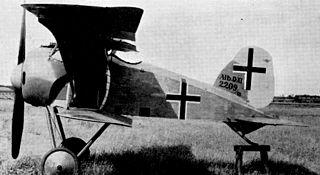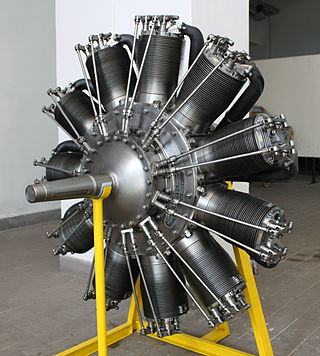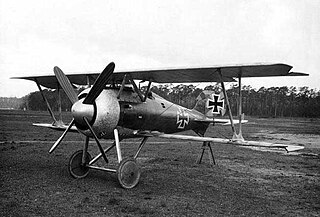| D.VI | |
|---|---|
 | |
| Role | Single seat fighter aircraft |
| National origin | Germany |
| Manufacturer | Siemens-Schuckert |
| First flight | early 1919 |
| Number built | 2 |
The Siemens-Schuckert D.VI was a single engine, single seat, parasol wing German fighter aircraft flown in 1919.
| D.VI | |
|---|---|
 | |
| Role | Single seat fighter aircraft |
| National origin | Germany |
| Manufacturer | Siemens-Schuckert |
| First flight | early 1919 |
| Number built | 2 |
The Siemens-Schuckert D.VI was a single engine, single seat, parasol wing German fighter aircraft flown in 1919.
The Idflieg ordered three prototypes of the parasol winged E.IV in April 1918. Renamed D.VI in September, two were completed early in 1919, after the Armistice with Germany. [1]
In plan the wing of the D.VI was more complicated than most, with the chord narrowest in the centre section, increasing outwards then decreasing somewhat towards the wing tips from about mid-span. Most of the curvature was on the trailing edge, assisting the pilot's vision from his cockpit there. The wing thickness also varied along the span, thinnest in the centre then increasing and decreasing again. The wing carried overhung, balanced ailerons and was braced with a pair of slightly converging, outward leaning struts to the thickest part of the wing from the lower fuselage. Its centre section was supported by a pair of short, vertical N-form cabane struts from the upper fuselage. [1] [2]
The fuselage of the D.VI was circular in cross-section, with its 11-cylinder, 160 hp (119 kW) Siemens-Halske Sh.IIIa rotary engine completely cowled in the nose driving a four blade propeller. The fuselage diameter decreased markedly to the tail but an unusual jettisonable fuel tank bulged out below for about 35% of the overall length. The blunt delta shaped tailplane was mounted at mid-fuselage height and had a single balanced elevator. The fin was small, with a generous, balanced, swept back, blunt topped rudder. The fighter had a simple, fixed conventional undercarriage, with mainwheels on a single axle supported by wire braced V-struts to the lower fuselage. Its tall tailskid was faired aft forming a little ventral fin. [1] [2]
The D.VI was test flown between February and May 1919 with promising speed and climb rates, though one of the two prototypes was lost. The other was reputedly destroyed by the Siemens-Schuckert staff to prevent its acquisition by the Aeronautical Inter-Allied Commission of Control, that began work in 1918. [1] [2]
Data fromGerman Aircraft of the First World War [2]
General characteristics
Performance

Siemens-Schuckert was a German electrical engineering company headquartered in Berlin, Erlangen and Nuremberg that was incorporated into the Siemens AG in 1966.

The Siemens-Schuckert D.IV was a late-World War I fighter aircraft from Siemens-Schuckert (SSW). It reached service too late and was produced in too few numbers to have any effect on the war effort.

The Albatros D.XI was a German single-seat fighter sesquiplane first flown in February 1918. It was the first Albatros fighter to use a rotary engine, in the form of the 120 kW (160 hp) Siemens-Halske Sh.III, and also featured a new wing construction with diagonal struts from the fuselage replacing traditional wire bracing.

The Siemens-Halske Sh.III was an 11-cylinder, air-cooled counter rotary engine developed in Germany during World War I. The engine was a development of the earlier 9-cylinder Siemens-Halske Sh.I.

The Siemens-Schuckert D.I was a single-seat fighter built by Siemens-Schuckert Werke in 1916. It was a German copy of the French Nieuport 17 that was obsolete by the time it was available in numbers, so that it served mainly as an advanced trainer.

The Siemens-Schuckert D.III was a German single-seat fighter built by Siemens-Schuckert Werke. The D.III was a development of the earlier Siemens-Schuckert D.IIc prototype. The D.III was an (nearly) equal-span biplane powered by a 160 hp (119 kW) Siemens-Halske Sh.III bi-rotary engine. Idflieg placed an order for 20 aircraft in December 1917, followed by a second order of 30 aircraft in February 1918.

The Siemens-Schuckert E.I was a German fighter aircraft, manufactured by Siemens-Schuckert.

The Siemens-Schuckert DDr.I was a World War I German twin engine, push-pull configuration triplane fighter aircraft. Only one was built, crashing on its first flight.
The Kondor E 3, sometimes erroneously known as E.III, was a German single seat, monoplane fighter aircraft designed and built close to the end of World War I. Though successful in the third D-type fighter competition at Aldershof in September 1918, only a few were produced, given the Idflieg designation of Kondor D.I.

The Kondor D 6 was a prototype German biplane fighter aircraft flown in 1918. In the interests of better upward vision for the pilot, its upper wing was in two halves, separated over the central fuselage. Its development was soon abandoned.
The Pfalz D.VII was a German biplane fighter aircraft from World War I. It was not put into production.

The Luft-Fahrzeug-Gesellschaft (LFG) Roland D.VII was a German single seat, single engine biplane fighter aircraft built during World War I. Problems with its underdeveloped V-8 engine prevented its production.

The LFG Roland D.IX was a World War I German single seat fighter aircraft, a biplane powered by one of a new generation of powerful rotary engines. Three slightly different prototypes were built but there was no series production.

The LFG Roland D.XV was a World War I German single seat fighter aircraft, ordered as a test-bed for engine comparisons. It was distinguished from earlier Roland biplane designs by the elimination of flying wires. Two later aircraft, also called LFG Roland D.XV, were completely different designs with slab sided fuselages.

The LFG Roland D.XVI, initially designated the LFG Roland E.I, was a single-seat, single-engine, parasol wing German fighter aircraft flown close to the end of World War I. Only two were built.

The LFG Roland D.XVII was a single-seat, single-engine, parasol wing German fighter aircraft flown close to the end of World War I. Only one was built.
The Siemens-Schuckert Dr.I was a German single seat triplane fighter aircraft first flown in 1917. Its development and that of a more powerful, uncompleted variant, was abandoned after a flight test programme.
The Siemens-Schuckert B was an unarmed German two seat reconnaissance biplane built early in World War I. A single example was delivered but soon lost.
The Dietrich-Gobiet DP.VII was a simple, low power, German sports aircraft flown in early 1924.

The Raab-Katzenstein KL.1 Schwalbe (Swallow) was a German two-seat biplane produced in the 1920s. About fifty were built and the type became well known as an aerobatic aircraft, performing at many displays in the hands of pilots like Gerhard Fieseler.